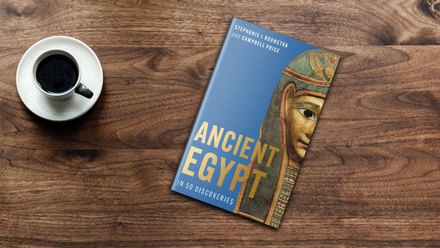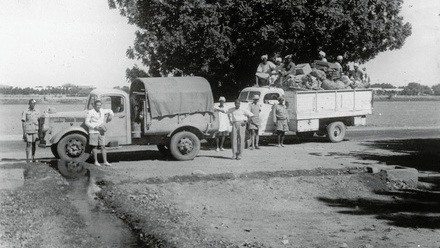Rediscovering Pendlebury's 'Crock of Gold'
by Katherine Piper
As part of the 2014-15 EES volunteer projects Katherine Piper and Louise Atherton have been scanning object cards from the Society’s excavations at Amarna (1921-1936). During her scanning Katherine came across the fabulous items described by Mary Chubb in Nefertiti Lived Here and describes these findings in greater detail here.
The 1930-31 EES season at Amarna was the first directed by John Pendlebury for the Society, and was chronicled by the EES secretary Mary Chubb in her book Nefertiti Lived Here, published much later as a memoir in 1954 (reprinted 1998). The book is well worth a read: it’s not intended as a concise archaeological report, but as a humourous account of Mary’s experience of her first archaeological expedition, and provides a brilliant insight into the characters and events of the time (I particularly enjoyed John Pendlebury announcing, “My Majesty requires beer,” whenever things went well).
Nefertiti Lived Here was of particular interest to me, because over the past few months, alongside my fellow volunteer Louise Atherton, I have been half of the project to scan the vast archive of object cards from the EES’s work at Amarna from 1921 to 1937. I was lucky enough that my assigned cards to scan included those from the 1930-31 and 1931-32 seasons, many of which were drawn by Mary Chubb. Object registration fell largely under Mary’s remit, as she had originally been allowed to join the expedition in order to act as a kind of field secretary to the project (to improve the quality of the accounts and reports which would be processed by the London office at the end of the season), and also happened to be a keen and talented artist herself - in Nefertiti Lived Here, Mary notes that H. W. Fairman, who shared registration duties with her and taught her the principles of object registration, insisted on having practically no artistic ability and produced accurate object sketches by meticulously measuring everything that crossed his bench, “... whilst I, who rather fancied my draughtsmanship, was told to hold onto myself and never mind about art.” (Chubb 1954: 79) Fortunately - from my point of view - Mary seems to have largely ignored this last piece of advice, because the object sketches on her cards are highly technically accomplished, and absolutely beautiful. It has been a pleasure and a privilege to be able to see all of her hard work, and it’s fantastic that her artwork will soon be available online for everyone to see.
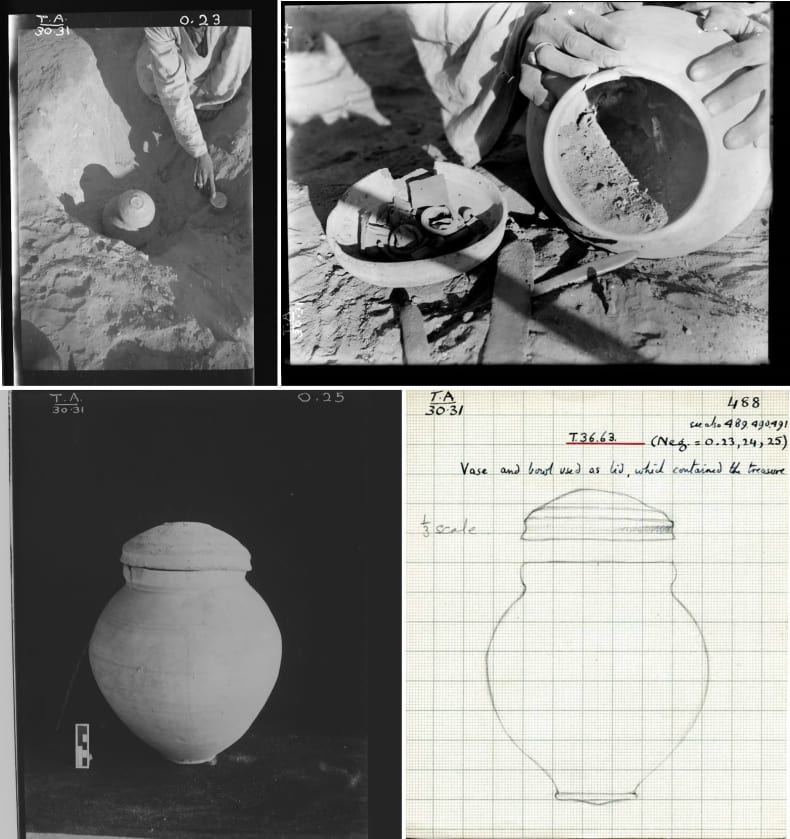
Negatives and object card relating to the discovery of the 'crock of gold' (TA.OC.30-31.488)
Of the many impressive finds of the 1930-31 season, one particular highlight was what John Pendlebury dubbed the “Crock of Gold”: a pottery jar with a cracked saucer acting as a lid, which was found beneath the floor of house T.36.63, and which contained a small hoard of several unworked bars and ingots of gold and silver. In amongst the bullion was a small figurine, identified by Pendlebury as being of Hittite design. As the only part of the hoard deemed to be of any archaeological value, Mary described it thus:
It was a tiny amulet figure about an inch high, made of silver with a ring at the back to thread on a chain. On the head with its large eyes and beaky nose, was a little round cap of gold. It was as if the gold and silver amulet had been slipped in as a kind of mascot, to guard the hoard made up of the same stuff of which he was fashioned, until times were safe for his master to unearth the treasure.
Mindful of the fact that Egyptian Museum would most probably “swipe” the figurine at the division of finds between the Department of Antiquities and the EES in Cairo at the end of the season, but keen to keep a copy of it, Mary asked permission to make a “cuttlefish cast” of it, baffling not only John Pendlebury but probably most people who have ever read the book:
“Cuttlefish casts,” he repeated, looking a little dazed. I explained that I had brought out enough dried cuttlefish in one of my suitcases to start a canary farm. “Canary farm,” he said. “Go on - I’m doing my best.” “But not for canaries,” I said. “Casts. It’s a technique used by jewellers - in fact, it was a London jeweller who put me up to this and gave me the outfit, and showed me how. He said that if I could make a lead cast of any small objects we found, he would make replicas for us from it, in the same material as the original; but it would have to be something not too fragile.”
In a nutshell, the technique is to press halved dried cuttlefish onto the object to be cast, creating an impression on their soft insides, which is then used as a mould to be filled with lead to make the cast. Hilary Waddington gamely melted down a few of his gun cartridges to make the casts, from which Mary’s jeweller was able to make several replicas of the figurine in silver and gold (this practice would most likely be frowned upon by the Ministry of State for Antiquities today).
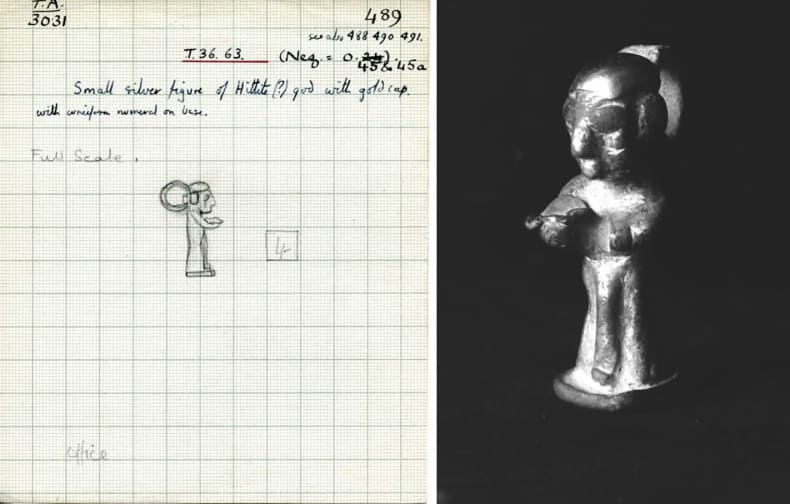
The small 'Hittite' amulet discovered within the 'crock of gold' (TA.OC.30-31.489)
When it came to the division of the season’s finds in Cairo, the finds were examined at the Egyptian Museum by the head of the Department of Antiquities, Pierre Lacau, referred to by the museum registrar Reginald Engelbach (and Mary) as “the Old Man” (Lacau would have been 58 in early 1931):
“I do not want all the gold and silver,” said the Old Man, “but this little man I must have - he is interesting. We will retain one half of your hoard - you may keep the other.”
The EES committee later decided that their share of the gold and silver could be sold for its bullion value, and were paid £200 for it by the Bank of England. The proceeds of the “Crock of Gold” went towards funding the Society’s next season at Amarna.
Chubb, M. 1998. Nefertiti Lived Here. London: Libri Publications Limited (available in the EES Library)
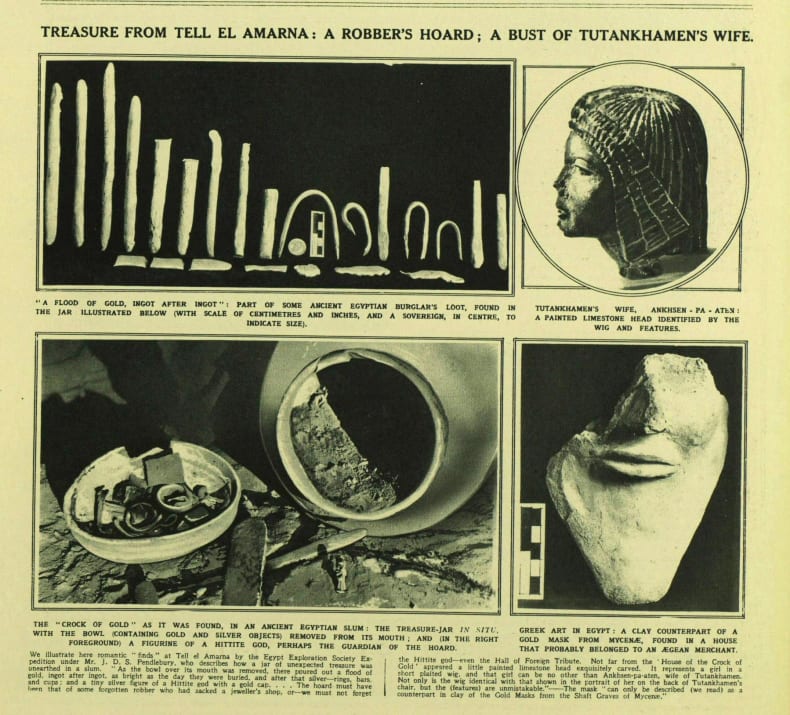 Pendlebury's published report of the discovery in the Illustrated London News in December 1930. The EES Ricardo Caminos Memorial Library contains many cuttings from the Illustrated London News relating to our work in Egypt which will soon be searchable via the new library catalogue.
Pendlebury's published report of the discovery in the Illustrated London News in December 1930. The EES Ricardo Caminos Memorial Library contains many cuttings from the Illustrated London News relating to our work in Egypt which will soon be searchable via the new library catalogue.
How can you support work in our collections?
If you would like to support the Society’s Collections, then please consider donating here. Funds generated will go directly to providing conservation and care, and improving access to our collections and will be kept in a restricted fund for this purpose.
You may also have seen the recent project by MicroPasts crowdsourcing transcriptions for the 1930-31 object cards, to get involved you can visit their website here.

